Thurgood Marshall Childhood
This essay about Thurgood Marshall’s early life highlights how his upbringing in Baltimore, amid racial segregation, shaped him into a future Supreme Court Justice. It describes the influence of his family, particularly his father, who instilled in him a deep respect for the law and his mother, a teacher who emphasized the importance of education. Despite the challenges of segregation, Marshall’s brilliance and determination were evident from a young age, driving him to pursue higher education and eventually lead landmark legal battles for civil rights. Through personal anecdotes and reflections on Marshall’s formative years, the essay paints a picture of how his childhood experiences and family values laid the groundwork for his historic contributions to justice and equality in America.
How it works
Let’s take a trip back to the heart of Baltimore, Maryland, where on a summer day in 1908, the world was graced with Thurgood Marshall. This wasn’t just any child; this was a boy who would grow up amid the harsh realities of racial segregation yet rise to become the first African American to sit on the U.S. Supreme Court. The story of his early years is not just a tale of overcoming adversity but a peek into the making of a man who would change the course of American history.
Thurgood’s upbringing was humble, his family not wealthy but rich in values and aspirations. His dad, William, was a railroad porter, but also a man with a deep respect for the American legal system, often taking young Thurgood to court to watch cases unfold. This wasn’t your typical father-son bonding activity, but these courthouse visits sparked a fire in Thurgood. They taught him to question, to listen, and most importantly, to understand the power of law.
Education was the family’s beacon of hope. Thurgood’s mom, Norma, was a teacher who believed fiercely in the transformative power of education, scrimping and saving to afford books. Despite attending segregated schools that offered limited resources, Thurgood’s brilliance shone. He wasn’t just smart; he was motivated, driven by the injustices he saw and experienced, using every obstacle as a stepping stone towards his goals.
Imagine a young Thurgood, navigating the segregated streets of Baltimore, his mind racing with dreams and schemes, fueled by the injustices he saw daily. This environment, combined with his family’s unyielding support and encouragement, was the perfect storm that propelled him towards greatness. His time at Frederick Douglass High School, and later at Howard University School of Law, wasn’t just about acquiring knowledge; it was about preparing to challenge the very fabric of American society.
Thurgood Marshall’s story is a powerful reminder that heroes aren’t born; they’re made, forged in the fires of their struggles, their environments, and their unbreakable wills. His early years were filled with lessons on resilience, the importance of questioning authority, and the belief that justice should be accessible to all. These weren’t just idle lessons; they were the principles that would guide his work with the NAACP, leading to landmark victories like Brown v. Board of Education, which struck a blow against racial segregation in public schools.
Reflecting on Thurgood Marshall’s childhood, it’s clear that his path to legal stardom was as much about his character and determination as it was about his intellect. His life is a testament to the idea that greatness is often a product of one’s early environment and experiences. In Thurgood’s case, it was a combination of family, education, and a relentless pursuit of justice that shaped him into the formidable force he became.
Thurgood Marshall’s early years remind us that behind every legend lies a story of a young person finding their way in the world, armed with dreams and the support of those who believe in them. It’s a narrative that inspires, reminding us of the potential within each of us to effect change, to challenge the status quo, and to stand up for what we believe in. So, as we celebrate Thurgood Marshall’s contributions to justice and equality, let’s also remember the boy from Baltimore who dared to dream big and, in doing so, changed the world.

Cite this page
Thurgood marshall childhood. (2024, Apr 07). Retrieved from https://papersowl.com/examples/thurgood-marshall-childhood/
"Thurgood marshall childhood." PapersOwl.com , 7 Apr 2024, https://papersowl.com/examples/thurgood-marshall-childhood/
PapersOwl.com. (2024). Thurgood marshall childhood . [Online]. Available at: https://papersowl.com/examples/thurgood-marshall-childhood/ [Accessed: 11 Apr. 2024]
"Thurgood marshall childhood." PapersOwl.com, Apr 07, 2024. Accessed April 11, 2024. https://papersowl.com/examples/thurgood-marshall-childhood/
"Thurgood marshall childhood," PapersOwl.com , 07-Apr-2024. [Online]. Available: https://papersowl.com/examples/thurgood-marshall-childhood/. [Accessed: 11-Apr-2024]
PapersOwl.com. (2024). Thurgood marshall childhood . [Online]. Available at: https://papersowl.com/examples/thurgood-marshall-childhood/ [Accessed: 11-Apr-2024]
Don't let plagiarism ruin your grade
Hire a writer to get a unique paper crafted to your needs.

Our writers will help you fix any mistakes and get an A+!
Please check your inbox.
You can order an original essay written according to your instructions.
Trusted by over 1 million students worldwide
1. Tell Us Your Requirements
2. Pick your perfect writer
3. Get Your Paper and Pay
Hi! I'm Amy, your personal assistant!
Don't know where to start? Give me your paper requirements and I connect you to an academic expert.
short deadlines
100% Plagiarism-Free
Certified writers
Marshall, Thurgood
July 2, 1908 to January 24, 1993
As an attorney fighting to secure equality and justice through the courts, Thurgood Marshall helped build the legal foundation for Martin Luther King’s challenges to segregation. On 6 February 1958, King wrote Marshall to express his gratitude for Marshall’s efforts in the Montgomery bus boycott : “We will remain eternally grateful to you and your staff for the great work you have done for not only the Negro in particular but American Democracy in general” ( Papers 4:360 ).
Born in Baltimore, Maryland, Marshall grew up in a middle class, politically active black family, and was taught early on to challenge injustice. Marshall earned his BA from Lincoln University in 1930. Unable to enroll at the University of Maryland because of its Jim Crow admission policy, Marshall attended Howard University Law School (JD, 1933). After working in the National Association for the Advancement of Colored People (NAACP) national office as an assistant to chief counsel Charles Houston, his former law school professor, Marshall succeeded him as NAACP chief counsel in 1938. In 1940 he began directing the newly created NAACP Legal Defense and Educational Fund. Marshall argued several landmark court cases that banned segregation practices, most notably Smith v. Allwright (1944), which won blacks the right to vote in Texas primaries; Morgan v. Virginia (1946), which banned segregation on interstate passenger carriers; and Sweatt v. Painter (1950), which required the admittance of a qualified black student to the University of Texas Law School.
Marshall’s most historic victory came in 1954 with Brown v. Board of Education , in which Marshall argued successfully against the doctrine of “separate but equal,” convincing the court that segregated schools were inherently unequal, and beginning the process of school desegregation.
Despite common beliefs in American democracy and integrationist goals, King and Marshall disagreed over tactics. Rather than civil disobedience and demonstrations, Marshall favored legal remedies as more efficient and effective. “I used to have a lot of fights with Martin about his theory about disobeying the law. I didn’t believe in that.” Marshall recalled. “I thought you did have a right to disobey a law, and you also had a right to go to jail for it. He kept talking about Thoreau, and I told him … ‘If I understand it, Thoreau wrote his book in jail. If you want to write a book, you go to jail and write it’” (Marshall, 471). Marshall did acknowledge King as “a great speaker,” and conceded that the protests “achieved much. If you put them in the scale, they would weigh very heavy, because it reached people’s consciousness” (Marshall, 479).
In 1961 President John F. Kennedy appointed Marshall to the Second Circuit Court of Appeals, making him the second African American to serve as a federal appellate judge. From 1965 to 1967, Marshall served under President Lyndon B. Johnson as solicitor general, the government’s chief appellant lawyer before the Supreme Court, another first for an African American. In 1967 Marshall was confirmed to the Supreme Court, where he remained the first and only African American justice until he retired in 1991.
King to Marshall, 6 February 1958, in Papers 4:360 .
Marshall, Thurgood Marshall , ed. Tushnet, 2001.
Williams, Thurgood Marshall , 1998.
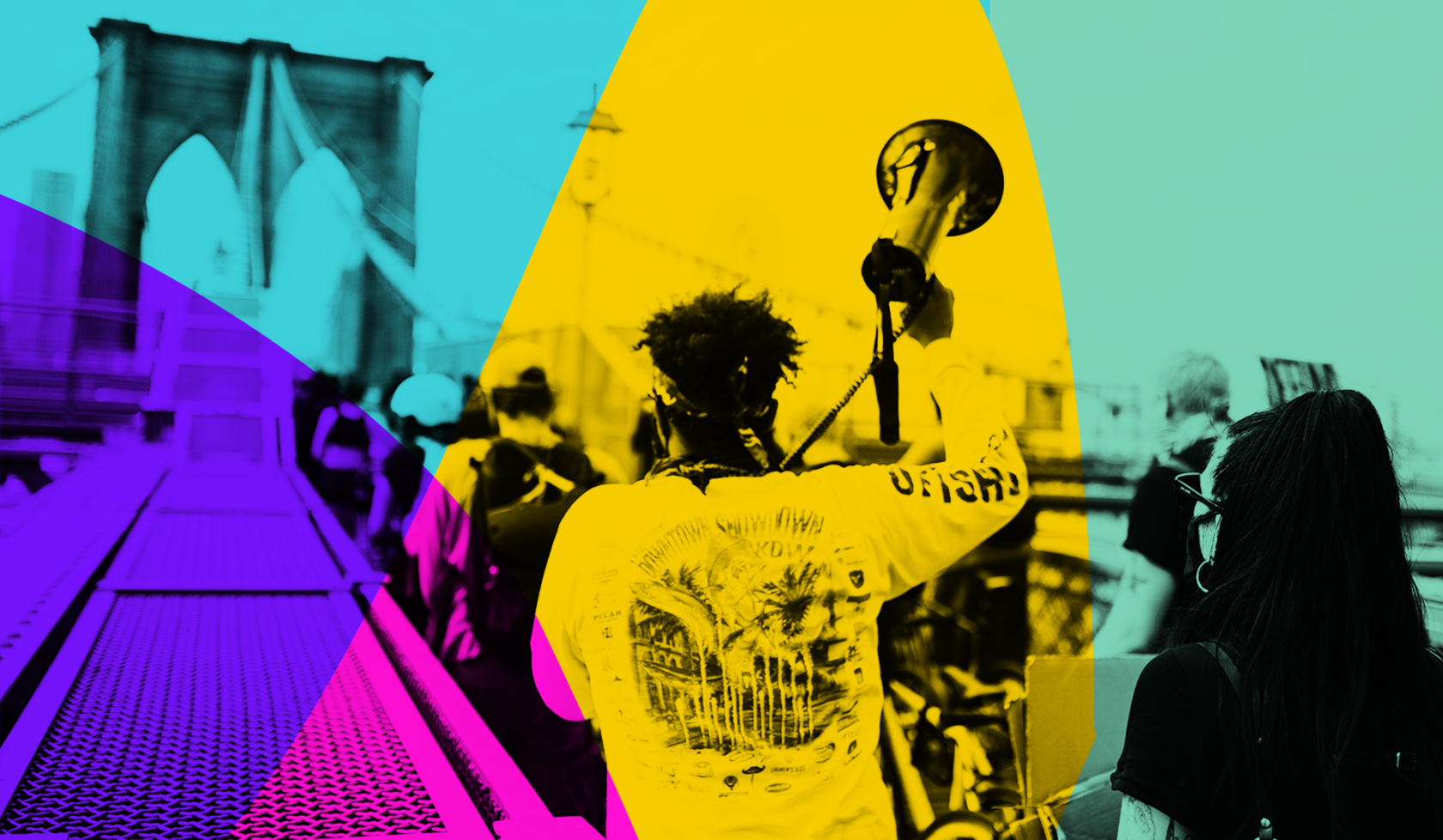
Thurgood Marshall
Thurgood Marshall was a civil rights lawyer who used the courts to fight Jim Crow and dismantle segregation in the U.S. Marshall was a towering figure who became the nation's first Black United States Supreme Court Justice. He is best known for arguing the historic 1954 Brown v. Board of Education case, in which the Supreme Court declared "separate but equal" unconstitutional in public schools.
A native of Baltimore, Maryland, Marshall graduated from Lincoln University in Pennsylvania in 1930. He applied to the University of Maryland Law School but was rejected because he was Black. Marshall received his law degree from Howard University Law School in 1933, graduating first in his class. At Howard, he met his mentor Charles Hamilton Houston, who encouraged Marshall and his classmates to use the law for social change.
The Legal Eagle
After graduating from Howard, one of Marshall's first legal cases was against the University of Maryland Law School in the 1935 case Murray v. Pearson . Working with his mentor Charles Hamilton Houston, Marshall sued the school for denying admission to Black applicants solely on the basis of race. The legal duo successfully argued that the law school violated the 14th Amendment guarantee of protection of the law, an amendment that addresses citizenship and the rights of citizens.
Soon after, Marshall joined Houston at NAACP as a staff lawyer. In 1940, he was named chief of the NAACP Legal Defense and Educational Fund, which was created to mount a legal assault against segregation.
Marshall became one of the nation's leading attorneys. He argued 32 cases before the U.S. Supreme Court, winning 29. Some of his notable cases include:
- Smith v. Allwright (1944), which found that states could not exclude Black voters from primaries
- Shelley v. Kraemer (1948), which struck down race-based restrictive housing covenants
- Sweatt v. Painter (1950), which deemed separate facilities for Black professional and graduate students unconstitutional
Marshall's most famous case was the landmark 1954 Brown v. Board of Education case in which Supreme Court Chief Justice Earl Warren noted, "in the field of public education, the doctrine of 'separate but equal' has no place. Separate educational facilities are inherently unequal."
Marshall's civil rights litigation work continues to this day.
A Supreme Legacy
President John F. Kennedy nominated Marshall to the U.S. Court of Appeals for the Second Circuit in 1961. Four years later, President Lyndon B. Johnson named Marshall U.S. solicitor general and on Aug. 30, 1967, Marshall was confirmed by the U.S. Senate and joined the U.S. Supreme Court, becoming the first Black justice.
During his nearly 25-year tenure on the Supreme Court, Marshall fought for affirmative action for minorities, held strong against the death penalty, and supported of a woman's right to choose if an abortion was appropriate for her. The civil rights lawyer turned Supreme Court justice made a significant impact on American society and culture. His mission was equal justice for all. Marshall used the power of the courts to fight racism and discrimination, tear down Jim Crow segregation, change the status quo, and make life better for the most vulnerable in our nation.
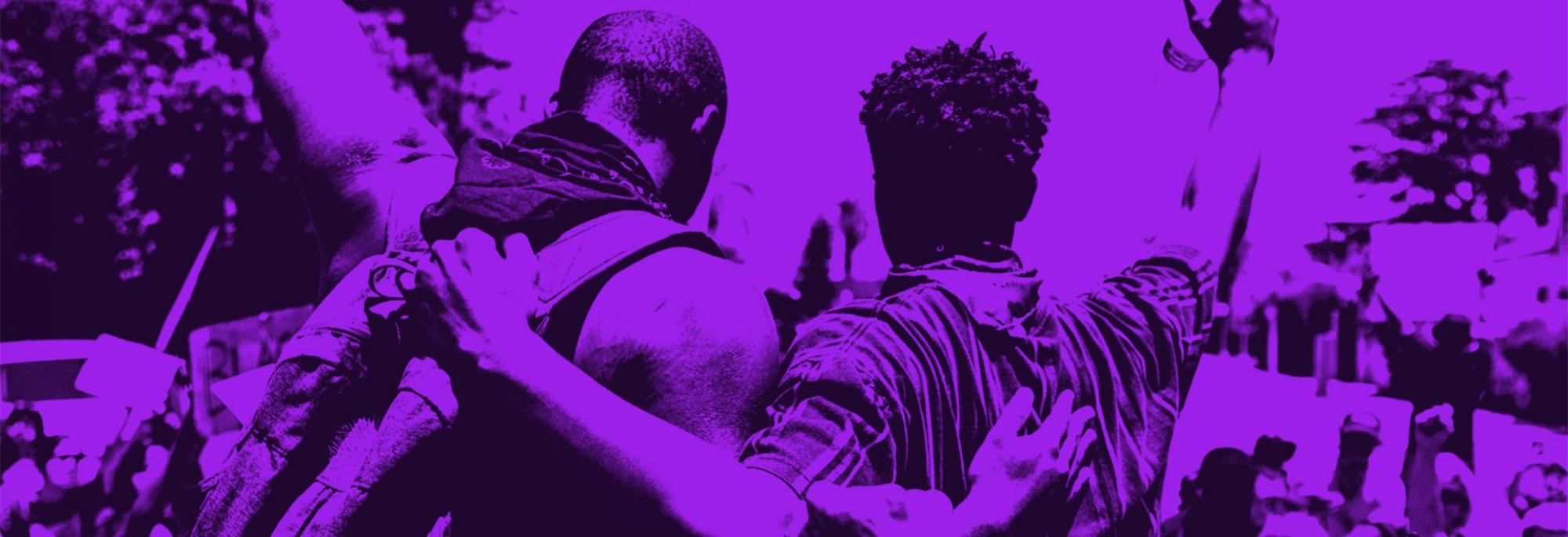
Meet other heroes who advanced racial justice
The voices of these visionaries shape our present and inform our future.
Join the fight
You are critical to the hard, complex work of ending racial inequality.
Thurgood Marshall
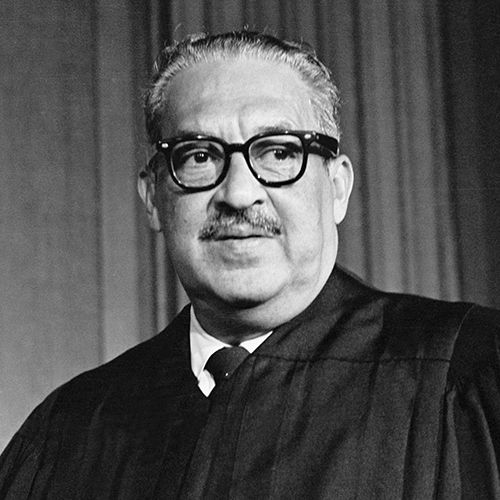
(1908-1993)
Who Was Thurgood Marshall?
Early life and family.
Marshall was born on July 2, 1908, in Baltimore, Maryland. His father, William Marshall, was the grandson of an enslaved person who worked as a steward at an exclusive club, and his mother, Norma, was a kindergarten teacher.
One of William's favorite pastimes was to listen to cases at the local courthouse before returning home to rehash the lawyers' arguments with his sons. Thurgood later recalled, "Now you want to know how I got involved in law? I don't know. The nearest I can get is that my dad, my brother and I had the most violent arguments you ever heard about anything. I guess we argued five out of seven nights at the dinner table."
Marshall attended Baltimore's Colored High and Training School (later renamed Frederick Douglass High School), where he was an above-average student and put his finely honed skills of argument to use as a star member of the debate team. The teenage Marshall was also something of a mischievous troublemaker. His greatest high school accomplishment, memorizing the entire United States Constitution , was actually a teacher's punishment for misbehaving in class.
After graduating from high school in 1926, Marshall attended Lincoln University, a historically Black college in Pennsylvania. There, he joined a remarkably distinguished student body that included Kwame Nkrumah, the future president of Ghana, poet Langston Hughes and jazz singer Cab Calloway .
After graduating from Lincoln with honors in 1930, Marshall applied to the University of Maryland Law School. Despite being overqualified academically, Marshall was rejected because of his race. This firsthand experience with discrimination in education made a lasting impression on Marshall and helped determine the future course of his career.
Instead of Maryland, Marshall attended law school in Washington, D.C. at Howard University, another historically Black school. The dean of Howard Law School at the time was the pioneering civil rights lawyer Charles Houston. Marshall quickly fell under the tutelage of Houston, a notorious disciplinarian and extraordinarily demanding professor. Marshall recalled of Houston, "He would not be satisfied until he went to a dance on the campus and found all of his students sitting around the wall reading law books instead of partying."
Marshall graduated magna cum laude from Howard in 1933. He briefly attempted to establish his own practice in Baltimore, but without experience, he failed to land any significant cases.
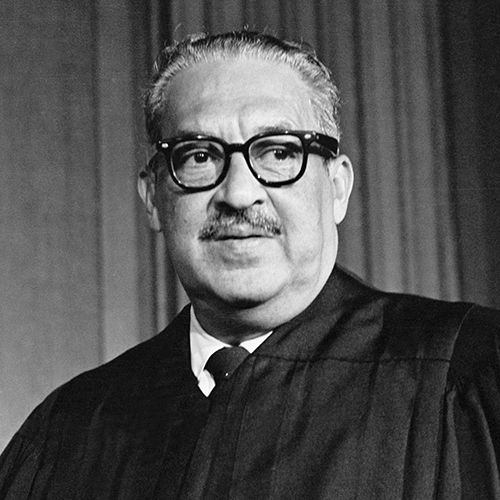
Court Cases
In 1934, Marshall began working for the Baltimore branch of the National Association for the Advancement of Colored People (NAACP). In 1936, Marshall moved to New York City to work full time as legal counsel for the NAACP. Over several decades, Marshall argued and won a variety of cases to strike down many forms of legalized racism, helping to inspire the American civil rights movement .
Murray v. Pearson
In one of Marshall's first cases — which he argued alongside his mentor, Charles Houston — he defended another well-qualified undergraduate, Donald Murray, who like himself had been denied entrance to the University of Maryland Law School. Marshall and Houston won Murray v. Pearson in January 1936, the first in a long string of cases designed to undermine the legal basis for de jure racial segregation in the United States.
Chambers v. Florida
Marshall's first victory before the Supreme Court came in Chambers v. Florida (1940), in which he successfully defended four Black men who had been convicted of murder on the basis of confessions coerced from them by police.
Smith v. Allwright
Another crucial Supreme Court victory for Marshall came in the 1944 case of Smith v. Allwright , in which the Court struck down the Democratic Party's use of white people-only primary elections in various Southern states.
Brown v. Board of Education
The great achievement of Marshall's career as a civil-rights lawyer was his victory in the landmark 1954 Supreme Court case Brown v. Board of Education of Topeka . The class-action lawsuit was filed on behalf of a group of Black parents in Topeka, Kansas, whose children were forced to attend all-Black segregated schools. Through Brown v. Board , one of the most important cases of the 20th century, Marshall challenged head-on the legal underpinning of racial segregation, the doctrine of "separate but equal" established by the 1896 Supreme Court case Plessy v. Ferguson .
On May 17, 1954, the Supreme Court unanimously ruled that "separate educational facilities are inherently unequal," and therefore racial segregation of public schools violated the equal protection clause of the 14th Amendment.
While enforcement of the Court's ruling proved to be uneven and painfully slow, Brown v. Board provided the legal foundation, and much of the inspiration, for the American civil rights movement that unfolded over the next decade. At the same time, the case established Marshall as one of the most successful and prominent lawyers in America.

Circuit Court Judge and Solicitor General
In 1961, newly-elected President John F. Kennedy appointed Marshall as a judge for the U.S. Second Circuit Court of Appeals. Serving as a circuit court judge over the next four years, Marshall issued more than 100 decisions, none of which was overturned by the Supreme Court.
In 1965, Kennedy's successor, Lyndon B. Johnson , appointed Marshall to serve as the first Black U.S. solicitor general, the attorney designated to argue on behalf of the federal government before the Supreme Court. During his two years as solicitor general, Marshall won 14 of the 19 cases that he argued before the Supreme Court.
Supreme Court Justice
In 1967, President Johnson nominated Marshall to serve on the bench before which he had successfully argued so many times before the United States Supreme Court. On October 2, 1967, Marshall was sworn in as a Supreme Court justice, becoming the first African American to serve on the nation's highest court. Marshall joined a liberal Supreme Court headed by Chief Justice Earl Warren , which aligned with Marshall's views on politics and the Constitution.
As a Supreme Court justice, Marshall consistently supported rulings upholding strong protection of individual rights and liberal interpretations of controversial social issues. He was part of the majority that ruled in favor of the right to abortion in the landmark 1973 case Roe v. Wade , among several other cases. In the 1972 case Furman v. Georgia , which led to a de facto moratorium on the death penalty, Marshall articulated his opinion that the death penalty was unconstitutional in all circumstances.
Throughout Marshall's 24-year tenure on the Court, Republican presidents appointed eight consecutive justices, and Marshall gradually became an isolated liberal member of an increasingly conservative Court.
For the latter part of his time on the bench, Marshall was largely relegated to issuing strongly-worded dissents, as the Court reinstated the death penalty and limited affirmative action measures and abortion rights. Marshall retired from the Supreme Court in 1991; Justice Clarence Thomas replaced him.
Personal Life and Wife
Marshall married Vivian "Buster" Burey in 1929, and the couple remained married until her death in 1955. Shortly thereafter, Marshall married Cecilia Suyat, his secretary at the NAACP. The couple had two sons together, Thurgood Jr. and John Marshall.
Marshall died on January 24, 1993, at the age of 84.
Legacy, Martin Luther King Jr. and Malcolm X
Marshall stands alongside Martin Luther King Jr. and Malcolm X as one of the greatest and most important figures of the American civil rights movement. Although he may be the least popularly celebrated of the three, Marshall was arguably the most instrumental in the movement's achievements toward racial equality.
Marshall's strategy of attacking racial inequality through the courts represented a third way of pursuing racial equality, more pragmatic than King's soaring rhetoric and less polemical than Malcolm X's strident separatism. In the aftermath of Marshall's death, an obituary read: "We make movies about Malcolm X, we get a holiday to honor Dr. Martin Luther King, but every day we live with the legacy of Justice Thurgood Marshall."
In 2017, the biopic film Marshall was released. Starring Chadwick Bosema n, Josh Gad and Kate Hudson , the movie focuses on an obscure 1941 rape case brought by Eleanor Strubing, a 32-year-old white woman, against her 32-year-old Black chauffeur, Joseph Spell. While Spell initially confessed to the crime after 16 hours of interrogation, he later said the encounter was consensual. During the trial, the judge allowed Marshall to assist his white co-attorney but banned him from speaking a single word. Following 12 hours of deliberation, the jury of six men and six women came back with a not guilty verdict.
QUICK FACTS
- Name: Thurgood Marshall
- Birth Year: 1908
- Birth date: July 2, 1908
- Birth State: Maryland
- Birth City: Baltimore
- Birth Country: United States
- Gender: Male
- Best Known For: Thurgood Marshall was instrumental in ending legal segregation and became the first African American justice of the Supreme Court.
- Civil Rights
- Astrological Sign: Cancer
- Howard University School of Law
- Lincoln University
- Colored High and Training School (Frederick Douglass High School)
- Interesting Facts
- In 1967, Thurgood Marshall became the first African American justice of the Supreme Court.
- Death Year: 1993
- Death date: January 24, 1993
- Death State: Maryland
- Death City: Bethesda
- Death Country: United States
We strive for accuracy and fairness.If you see something that doesn't look right, contact us !
CITATION INFORMATION
- Article Title: Thurgood Marshall Biography
- Author: Biography.com Editors
- Website Name: The Biography.com website
- Url: https://www.biography.com/legal-figures/thurgood-marshall
- Access Date:
- Publisher: A&E; Television Networks
- Last Updated: January 11, 2021
- Original Published Date: April 3, 2014
- There is very little truth in the old refrain that one cannot legislate equality.
- To those of us who know that struggle is far from over, history has another lesson. It tells us how deeply rooted habits of prejudice are.
- What's wrong with me? I'm old! I'm getting old and coming apart. [On announcing his retirement]
- We can always stick together when we are losing, but tend to find means of breaking up when we're winning.
- Surely the fact that a uniformed police officer is wearing his hair below his collar will make him no less identifiable as a policeman.
- I have a lifetime appointment and I intend to serve it. I expect to die at 110, shot by a jealous husband.
- Our moral leadership should come from the top executive of the government.
- Power, not reason, is the new currency of this Court's decision making.
- When the Democratic Convention failed to do anything about the Southerners, they lost my support.
- There's not a white man in this country who can say I never benefited by being white.
- Our whole constitutional heritage rebels at the thought of giving government the power to control men's minds.
- In recognizing the humanity of our fellow beings, we pay ourselves the highest tribute.
- Equal means getting the same thing, at the same time and in the same place.
- None of us got where we are solely by pulling ourselves up by our bootstraps. We got here because somebody—a parent, a teacher, an Ivy League crony or a few nuns—bent down and helped us pick up our boots.
- The measure of a country's greatness is its ability to retain compassion in times of crisis.
Civil Rights Activists

30 Civil Rights Leaders of the Past and Present

Benjamin Banneker
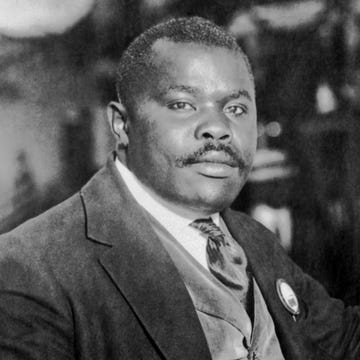
Marcus Garvey

Madam C.J. Walker

Maya Angelou

Martin Luther King Jr.
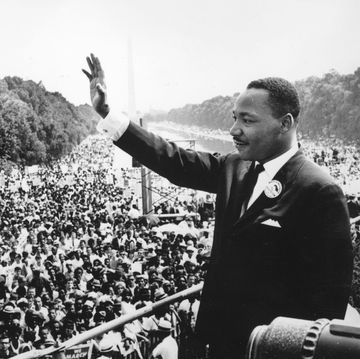
17 Inspiring Martin Luther King Quotes

Bayard Rustin

Colin Kaepernick
How Thurgood Marshall Paved the Road to ‘Brown v. Board of Education’
A case in Texas offered a chance for the prosecutor and future Supreme Court justice to test the legality of segregation
Sherrilyn Ifill
:focal(1750x1400:1751x1401)/https://tf-cmsv2-smithsonianmag-media.s3.amazonaws.com/filer/ff/de/ffde142a-63db-45fa-935f-e1e10401fb3d/gettyimages-515585588.png)
To cover the 400 years of Black America, we divided Four Hundred Souls into ten sections, each covering 40 years. The following essay from Sherrilyn Ifill, president and director-counsel of the NAACP Legal Defense Fund, covers the five-year-span from 1949 to 1954. Ifill describes the long campaign of desegregation cases brought by Thurgood Marshall, then president of the Legal Defense Fund, focusing on a suit that arose out of Hearne, Texas. World War II and its aftermath exposed the contrast to fighting fascism abroad while the system of Jim Crow governed the American South. The school system of Hearne, Texas, produced a stark example of this contradiction when, following a fire that destroyed the black high school, the white school superintendent decided that the barracks that once housed German prisoners of war should become the new segregated school. Ifill’s essay captures the long struggle for educational equality in the United States. — Ibram X. Kendi and Keisha N. Blain
In 1948, U.S. officials vigorously prosecuted German war criminals in Nuremberg for enforcing anti-Semitic policies, practices and laws that advanced a theory of ethnic and religious inferiority of Jews. At the same time, state officials across the American South were enforcing segregationist policies, practices and laws that advanced a theory of white supremacy and the racial inferiority of African Americans, undisturbed by the federal government.
In the small town of Hearne, Texas, starting in the fall of 1947, the contrast between the U.S. fight against Nazism abroad and its embrace of a rigid racial caste system at home was dramatized in a battle over segregated schools. The standoff between African American parents in Hearne and the local white school superintendent drew the attention of attorney Thurgood Marshall. Just eight years earlier the brilliant and determined young African American lawyer from Baltimore had founded the NAACP Legal Defense and Educational Fund (LDF). Marshall became the LDF’s first president and its director-counsel in 1940. Seventy-three years later, I became the LDF’s seventh president and director-counsel.
The story of LDF’s brilliant strategy to successfully challenge the constitutionality of racial segregation has been documented and chronicled in multiple books and articles. The strategy culminated in Brown v. Board of Education , a monumental 1954 landmark Supreme Court decision that literally changed the course of 20th-century America. The Court, led by Chief Justice Earl Warren, decided that “separate educational facilities are inherently unequal” and deprive black children of the constitutional right to equal protection of the laws. The decision cracked the load-bearing wall of legal segregation. Within ten years, the principles vindicated in Brown were successfully deployed to challenge segregation laws in the United States.
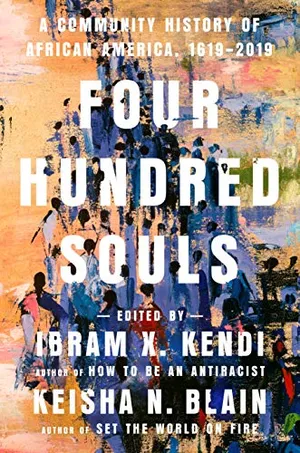
Four Hundred Souls: A Community History of African America, 1619-2019
This is a history that illuminates our past and gives us new ways of thinking about our future, written by the most vital and essential voices of our present.
The rather unknown story that unfolded in Hearne, Texas, captures the historical significance of Brown . Black parents were powerfully affected by the contrast between the U.S. stance against Nazis on the global stage and the embrace of Jim Crow at home. Their postwar ambitions for their children ran headlong into the determination of Southern whites to reinforce segregation. In communities around the South, Black parents sought and received the assistance of local NAACP lawyers to challenge the absence of school facilities for their children, or the substandard educational facilities and investment in Black schools.
In Hearne the challenge was initiated by C. G. Jennings, the stepfather of 13-year-old twins, Doris Raye and Doris Faye Jennings. In August 1947, he tried to register his daughters at the white high school. His request was refused, and he engaged local counsel.
A few weeks later, in September 1947, African American parents initiated a mass boycott. Maceo Smith, who led the NAACP in Dallas, contacted Marshall about the situation in Hearne.
A year earlier, the Blackshear School, the high school designated for black students, had burned down. No one expected the black students to now attend the nearby white school due to a Texas law segregating students. The school superintendent announced that $300,000 would be devoted to the construction of a new school for black students, and a $70,000 bond issue was placed on the ballot. Although black children outnumbered white students in Hearne, the physical plant of the existing high school for white students was estimated to have a value of $3.5 million. The building that would be haphazardly renovated into the “new” black high school was, in fact, the dilapidated barracks that had just recently housed German soldiers during the war.
When black parents learned about the city’s plans, they felt compelled to take matters into their own hands. According to reports in the local African American newspaper, “these buildings were sawed in half, dragged to the school location, and joined together with no apparent regard for physical beauty or concealing their prison camp appearance.” The complaint later filed by parents in Jennings v. Hearne Independent School District further described the school as “a fire hazard,” “overcrowded and . . . unfurnished with modern equipment,” and with “inadequate lighting.” All in all, the black parents deemed the building “unsafe for occupancy,” and the indignity of educating their children in a prisoner of war barracks was an insult too ugly to be borne.
White officials and local newspapers disparaged the parents’ school boycott and the Jennings suit as an attempt by the NAACP to “stir up trouble.” On September 28, Marshall—who recognized the importance of challenging media distortions to his litigation efforts—fired back at the editorial board of The Dallas Morning News with a lengthy letter.
As African American parents in Hearne kept their children home from school, 100 miles away in Houston, black schoolteacher Henry Eman Doyle was the sole law student registered at Texas State University for Negroes, a hastily organized three-room “school” created by the State of Texas after Marshall won a discrimination case brought on behalf of Heman Sweatt, a black student who had been barred from registering at the University of Texas Law School. The three-room school, located in the basement of the state capitol, was the state’s attempt to comply with the Plessy v. Ferguson “separate but equal” doctrine that required states to provide a public law school for black students if they excluded black students from flagship public law schools.
/https://tf-cmsv2-smithsonianmag-media.s3.amazonaws.com/filer/e5/f8/e5f87d3b-b558-43b1-a6a6-e6f599dbd8e3/gettyimages-640491199.jpg)
Marshall again challenged the state, and in 1950, the Supreme Court would find that Texas’s crude attempts at equality were in vain, and that at least in the area of law education, separate could not be equal. The decision is widely regarded as the final case that set the successful stage for the frontal attack on segregation that became Brown v. Board of Education .
Meanwhile, some federal judges found the courage to defy Southern mores and uphold the constitutional guarantee of equal protection. In South Carolina, federal court judge Julius Waties Waring, the scion of a respected Charleston family with deep Confederate roots, issued a series of unexpected decisions in cases tried by Marshall that suggested that federal judges might play a role in protecting civil rights. Waring’s searing, powerful dissent in Briggs v. Elliot , the South Carolina Brown case, became the template for the Supreme Court’s decision in Brown . Here Judge Waring first articulated the concept that “segregation is per se inequality”—a full-on rebuke of Plessy v. Ferguson that Chief Justice Warren later paraphrased in Brown .
Other civil rights lawyers, and the African American parents they represented, were also emboldened after World War II. And it was their energy and uncompromising demands that shifted the landscape. By 1951, African American students were making their own demands. In Prince Edward County, Virginia, 16-year-old Barbara Johns led her classmates at Moton High School in a walkout and boycott of their segregated school. Her action prodded Marshall and the LDF lawyers to file Davis v. Prince Edward County, Virginia , one of the four Brown cases.
Back in Hearne, by the time African American parents began organizing to challenge the dilapidated “new” high school for their children, Marshall already had his hands full with cases, all of which would become landmarks in their own right. The case was dismissed at the district court level and reaffirmed the principle of segregation in Texas schools.
The Hearne lawsuit was one of a cadre of small, unsuccessful cases extending back to Marshall’s late 1930s schoolteacher-pay-equality cases in Maryland and Virginia. But these cases played a powerful role in shaping the thinking of LDF lawyers about what was possible in their litigation challenging Jim Crow. And it powerfully demonstrated the civil rights challenge confronting the United States in those early postwar years.
As Thurgood Marshall wrote in his 1948 letter to the editors of The Dallas Morning News , “I think that before this country takes up the position that I must demand complete equality of right of citizens of all other countries throughout the world, we must first demonstrate our good faith by showing that in this country our Negro Americans are recognized as full citizens with complete equality.”
From the book FOUR HUNDRED SOULS: A Community History of African America, 1619-2019 edited by Ibram X. Kendi and Keisha N. Blain. "The road to Brown v. Board of Education " by Sherrilyn Ifill © 2021 Sherrilyn Ifill.
Published by permission of One World, an imprint of Random House, a division of Penguin Random House LLC. All rights reserved.
Get the latest History stories in your inbox?
Click to visit our Privacy Statement .
A Note to our Readers Smithsonian magazine participates in affiliate link advertising programs. If you purchase an item through these links, we receive a commission.
Thurgood Marshall: Supreme Court of the United States Essay
Thurgood Marshall, serving on the Supreme Court of the United States, was one of the prominent American jurists who played a pivotal role in shaping the history of civil rights in America. Being one of the start buttons for civil rights movement in the country, his influence is still felt to date (Gibson, 5). Thurgood served for twenty-four years then retired in 1991 because of old age and deteriorating health. He passed away on January24, 1993 being eighty-five years of age. Through the legal processes, Justice Thurgood eliminated the legacies of racism and segregation, which was even more instrumental in the civil rights revolution than the efforts of the other activists during the 20 th century.
In his career as a legal expert, Thurgood had many accomplishments. In collaboration with his mentor, Charles Hamilton, Thurgood strived to come up with appropriate ways of eradicating racial practices at the institutions of learning (Frost and Marshal, 17; Feldman, 34). The two intended to commence their work on the graduate and professional schools since they thought that the judges would assist them. After this, they had plans to shift their focus on the elementary and high schools. These efforts bore fruit during the case of Brown vs. The Board of Education in 1954 in which the Supreme Court ruled that segregation of schools was against the law (Haugen, 9). During this time, Thurgood was a sought-after advocate of the Supreme Court who argued his cases before the Court in a candid, straightforward and characteristic style.
In 1940, when he was only thirty-two years of age, Thurgood won the first United States Supreme Court case, Chambers v. Florida , and that same year, he was appointed the Chief Counsel for the National Association for the Advancement of Colored People (NAACP). He held this position up to 1961 and he assisted the organization in meeting one of its prime objectives: eliminating racial practices in the U.S. In 1961, President Kennedy appointed him to the Court of Appeals. However, he only managed to work for the initial several weeks by virtue of a congressional recess appointment when some of the legislators slowed down his affirmation. Thurgood served in the court up to 1965. From 1965, “he served as the Solicitor General under President Lyndon B. Johnson, and after the retirement of Justice Tom C. Clark in 1967, he was duly appointed to the Supreme Court” (Nazel, 157). He became the first African American to hold that position, and out of the 32 cases he argued before the body, he managed to be triumphant in 29 of them(Monroe, 4).
The success of Thurgood’s work was based on his belief that integration would permit the rights of every American to be protected. Although he fought for the rights of African Americans, he also succeeded in establishing the framework of individual rights that allowed the protections of the rights of all U.S. citizens. Justice Thurgood was successful in establishing the protections under the constitution for women, children, and the prisoners, and even the media can thank him for his assistance in expanding its liberties. Besides his success in the fields of civil rights and criminal procedure, Thurgood also played a role in the development of other areas of the law such as the formulation of the standard of materiality in the U.S. securities law and advocating for equal employment opportunities for veterans and non-veterans. Due to his unique perspective of the rule of law, Thurgood made significant contributions that has shaped today’s racial landscape.
Works cited
Feldman, Ruth T. Thurgood Marshall . Minneapolis : Lerner Publications, 2001. Print.
Frost, Helen, and Marshall, Thurgood. Thurgood Marshall . Mankato, Minn.: Pebble Books, 2003. Print.
Gibson, Karen B. Thurgood Marshall: a photo-illustrated biography. Mankato, Minn.: Bridgestone Books, 2002. Print.
Haugen, Brenda. Thurgood Marshall: civil rights lawyer and Supreme Court Justice. Minneapolis, Minn.: Compass Point Books, 2007. Print.
Monroe, Judy P. Thurgood Marshall: civil rights champion. Mankato, Minn.: Capstone Press, 2006. Print.
Nazel, Joseph. Thurgood Marshall : supreme court justice. Los Angeles: Melrose Square Pub., 1993. Print.
- Chicago (A-D)
- Chicago (N-B)
IvyPanda. (2022, January 7). Thurgood Marshall: Supreme Court of the United States. https://ivypanda.com/essays/thurgood-marshall-supreme-court-of-the-united-states/
"Thurgood Marshall: Supreme Court of the United States." IvyPanda , 7 Jan. 2022, ivypanda.com/essays/thurgood-marshall-supreme-court-of-the-united-states/.
IvyPanda . (2022) 'Thurgood Marshall: Supreme Court of the United States'. 7 January.
IvyPanda . 2022. "Thurgood Marshall: Supreme Court of the United States." January 7, 2022. https://ivypanda.com/essays/thurgood-marshall-supreme-court-of-the-united-states/.
1. IvyPanda . "Thurgood Marshall: Supreme Court of the United States." January 7, 2022. https://ivypanda.com/essays/thurgood-marshall-supreme-court-of-the-united-states/.
Bibliography
IvyPanda . "Thurgood Marshall: Supreme Court of the United States." January 7, 2022. https://ivypanda.com/essays/thurgood-marshall-supreme-court-of-the-united-states/.
- The Habeas Corpus Case of Neil v. Biggers
- Historically Black Colleges and Universities
- The African American Rights Movement Success
- State v. Odell, 676 N.W.2d 646: A Case Study
- Application Specific Internet of Things by Ang & Seng
- California Gold Rush: Diffusion of the Human Society
- University of Minnesota (Minneapolis, MN) Off-Campus Housing
- The History of the Agency
- Monograph of Winston Churchill
- Minneapolis Government Trends in Minimum Wage Increases
- Courts Seeking the "Original Meaning" of the Constitution
- The American Promise: Documents Review
- Supreme Court: The Case Research
- Supreme Court’s Interpretation of Democracy
- The Housing Right and Duties Bill
Civil Rights Digital Library
Searching help.
- Use quotation marks to search as a phrase
- Use "+" before a term to make it required (Otherwise results matching only some of your terms may be included)
- Use "-" before a word or phrase to exclude
- Use "OR", "AND", and "NOT" (must be capitalized) to create complex boolean logic
- You can use parentheses in your complex expressions
- Truncation and wildcards are not supported
Marshall, Thurgood, 1908-1993
61 items in 18 collections ( expand all )
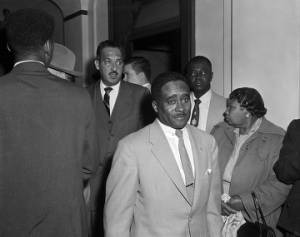
Arthur Shores and Thurgood Marshall after a hearing for Autherine Lucy at the federal courthouse in Birmingham, Alabama.
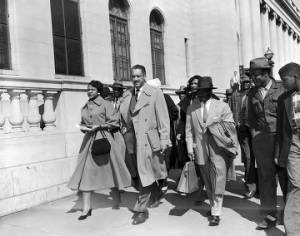
Autherine Lucy and her lawyers, Thurgood Marshall, Arthur Shores, and Constance Baker Motley, walking past the federal courthouse in Birmingham, Alabama, on the day a federal judge ordered her readmission to the University of Alabama.
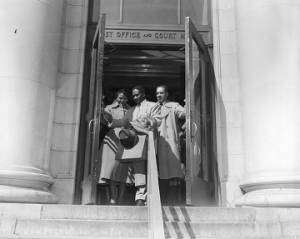
Autherine Lucy, Arthur Shores, and Thurgood Marshall leaving the federal courthouse in Birmingham, Alabama, after a hearing.
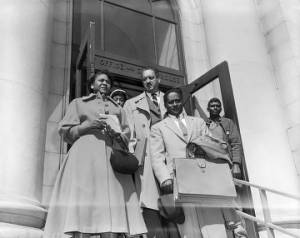
Autherine Lucy, Arthur Shores, and Thurgood Marshall outside the federal courthouse in Birmingham, Alabama, after a hearing.
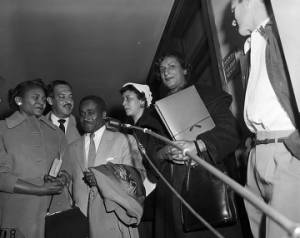
Autherine Lucy, Thurgood Marshall, and Arthur Shores after a hearing at the federal courthouse in Birmingham, Alabama.
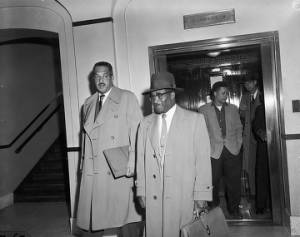
Thurgood Marshall and Arthur Shores after a hearing for Autherine Lucy at the federal courthouse in Birmingham, Alabama.

Interview with Lyman T. Johnson, June 24, 1991
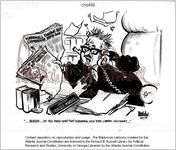
--Burger-- Do you know what that screaming, wild eyed liberal has done?-- / Baldy, 1973 Aug. 7

--T-h-e-r-e--! Something for everybody!-- / Baldy, [1978 June 30]

Barbara Jordan, Thurgood Marshall Tribute, American Civil Liberties Union of Hawaii

Cecilia Suyat Marshall oral history interview conducted by Emilye Crosby in Washington, D.C., 2013-06-30
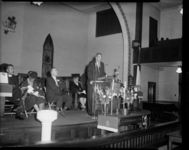
Justice Thurgood Marshall speaking from podium in Wesley Center A.M.E. Zion church with men and women seated behind him, including Bishop Charles Foggie on left

Thurgood Marshall
Dr. robert w. saunders, sr. / interviewed by canter brown.

CORE--Arrests and bail forms, 1963-1964 (Congress of Racial Equality. Mississippi 4th Congressional District records, 1961-1966; Historical Society Library Microforms Room, Micro 793, Reel 1, Segment 3)

CORE--Educational materials - Workbooks, outlines, handbooks, 1963-1965 (Congress of Racial Equality. Mississippi 4th Congressional District records, 1961-1966; Historical Society Library Microforms Room, Micro 793, Reel 2, Segment 22)
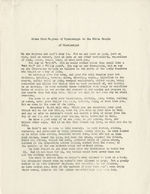
Council of Federated Organizations Panola County Office --Miscellany (Council of Federated Organizations Panola County Office records, 1963-1965; Archives Main Stacks, Mss 521, Box 1, Folder 13)
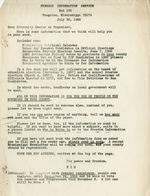
Dunlap--Mississippi Freedom Project, 1964-1965 (Papers, 1964-1972, 1994; Z: Accessions, M2000-007, Box 2, Folder 5)
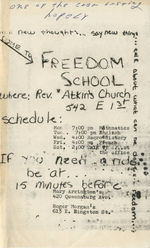
Kaplow--Friends of SNCC - General, 1964-1967, undated (Alicia Kaplow papers, 1964-1968; Archives Main Stacks, Mss 507, Box 1, Folder 7)

Lynd--Printed material, February 1963-October 1965 & undated (Staughton and Alice Lynd papers 1938-2008; Archives Main Stacks, Mss 395, Box 5, Folder 1)

Oral history interview with David Gambrell, 1992 September 21
Oral history interview with gwen jackson, june 31, 1995, part i.

Full Text Order for Appearance of Thurgood Marshall, Who Argued the Case for School Desegregation [Brown v. Board of Education]
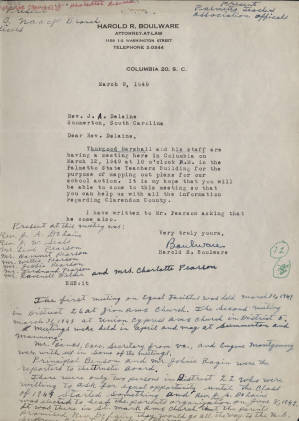

Letter, 1949 Mar. 8, (Columbia, S.C.), Harold R. Boulware, to Joseph A. De Laine, Sr., (Summerton, S.C.)
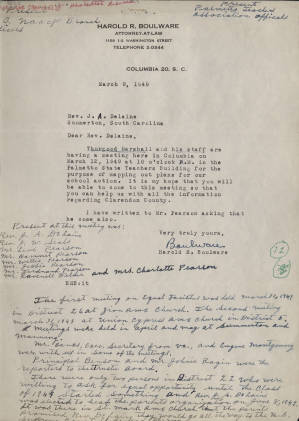
Letter, 1949 Mar. 8, (Columbia, S.C.), Harold R. Boulware, to Joseph A. DeLaine, Sr., (Summerton, S.C.)

Letter, 1961 Dec. 11, (New York, N.Y.), Roy Wilkins, to Joseph A. DeLaine, Sr., (Hollis, Long Island, N.Y.)

Petition, 1949 Nov. 11, (Clarendon County, S.C.) Harry Briggs, et al., to the Board of Trustees for School District No. 22 (Clarendon County, S.C.)
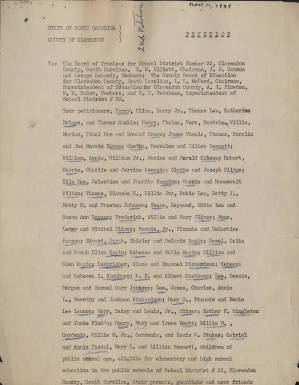
Petition, 1949 Nov. 11, Harry Briggs, et al., to the Board of Trustees for School District No. 22, Clarendon County Board of Education (S.C.)

[Early civil rights activities, people and events in the life of Rosa Parks, 1956-1966] [graphic].
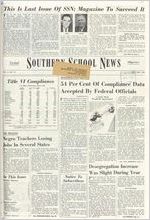
Southern school news
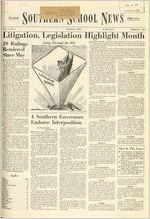
LAWYERS ON WHO MIGHT HAVE WON THE DESEGREGATION COURT BATTLE
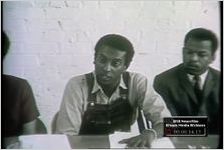
Series of WSB-TV newsfilm clips of members of the Student Nonviolent Coordinating Committee (SNCC) discussing the "Black Power" philosophy, Atlanta, Georgia, 1966 May 23
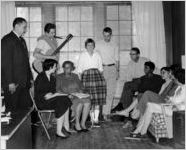
Civil rights meeting with Thurgood Marshall
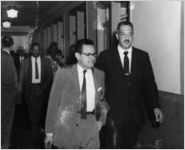
Wiley Branton and Thurgood Marshall
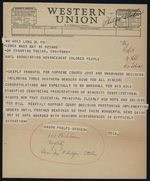
Anson Phelps Stokes to Channing Tobias, Chairman of the NAACP, offering congratulations on the NAACP's victory in Brown v. Board of Education.
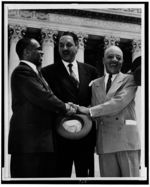
George E. C. Hayes, Thurgood Marshall, and James M. Nabrit congratulating each other
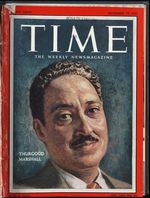
Time magazine, September 19, 1955. Cover
3 items in 3 collections ( expand all )

17-1 Lesson taken from the First Book of Negroes, page 1

Constance Baker Motley

Thurgood Marshall Before the Court
Support trustworthy, independent journalism that sheds light on the darkest corners of our justice system through journalism — fighting misinformation and leading to real change.
The Awakening of Thurgood Marshall
The case he didn’t expect to lose. and why it mattered that he did..
From time to time, The Marshall Project will look back at the history of American justice and injustice. We begin with a watershed moment in the life of our namesake.
He didn’t know it then, but when Thurgood Marshall boarded an Oklahoma-bound train at New York’s Pennsylvania Station in January of 1941 to defend a young, black sharecropper accused of murdering a white family and burning down their home, he was just days away from the case that would fortify his commitment to overhauling the criminal justice system as he knew it. The murder trial of the sharecropper, W.D. Lyons, would be a watershed moment in Marshall’s career as a lawyer, and despite the fact that he lost the case, which ultimately led to a rare and devastating defeat before the U.S. Supreme Court, the special counsel for the NAACP’s Legal Defense and Educational Fund would leave Oklahoma with an unbridled hope for the future.
The Lyons trial wasn’t Marshall’s first criminal case. He had, in fact, already argued and won Chambers v. Florida before the Supreme Court, which ruled unanimously that coerced confessions by police are inadmissible at trial. The court’s 1940 opinion, however, had done little to stem the tide of police beatings during the interrogation of black suspects in the Jim Crow South. Marshall and his team of LDF lawyers had their desktops piled high with capital cases in which suspects’ confessions were believed to have been compelled by law enforcement officers through duress.

Thurgood Marshall outside the Supreme Court building in 1955.
The case that brought Marshall to Hugo, Okla., in 1941, was one of the most extreme. On the evening of Dec. 31, 1939, Mr. and Mrs. Elmer Rogers had been attacked (by ax and shotgun) and killed in their home. Their tenant house was then doused with coal oil and set afire, and 8-year-old James Rogers managed to flee the home, carrying his baby brother, Billie Don, to safety. Four-year-old Elvie Dean Rogers perished in the blaze.
Newspapers at the time reported that officials from the Fort Towson prison camp (adjacent to the Rogers home) had allowed prisoner-trustees to go on unsupervised hunting expeditions with shotguns, and even gamble and consume alcohol with local residents. After a farmer signed an affidavit claiming that he had witnessed three convicts enter the Rogers home on the night of the murders, warden Jess Dunn promptly closed the prison camp and shuttled all convicts to the more secure state penitentiary in McAlester. A camp sergeant was soon fired amid reports that two convicts, who had lost $90 to Rogers in a dice game earlier that evening, had been arrested after confessing to the murders. But Oklahoma Gov. Leon Chase Phillips surely sensed in the lax discipline at the prison camp the potential for a crippling political scandal. He dispatched his special investigator, Vernon Cheatwood to Fort Towson, and after Cheatwood’s investigation, the two arrested convicts were released 1 , and an illiterate, 21-year-old black sharecropper, W.D. Lyons, was arrested by local police.
Over the course of the next two days, Lyons was beaten senseless and told to confess to the murders. Denied sleep and food, and still groggy from the beatings, Lyons was visited in the middle of the night by the special investigator, who approached with a large black pan, which he dropped in the sharecropper’s lap. “There’s the bones of the baby you burned up,” Cheatwood told him.
Superstitious and in fear for his life, Lyons broke down as Cheatwood grabbed him by the neck and pushed his face into the pan. Only a confession would end his agony, Lyons was told, and the young sharecropper quickly obliged. He later stated that he confessed twice because he “didn’t want to be tortured anymore” and “couldn’t stand any more of the beating.”
In an uncharacteristically slow crawl toward justice, Lyons lingered in prison. Marshall believed that the Choctaw County attorney was “scared to try the case for a whole year” because the Fort Towson prison camp scandal might erupt again and become an issue in local elections.
By the time Marshall arrived in Hugo, word had already spread that a “nigger lawyer from New York” was on the case. The courthouse was packed with locals, and when he assumed his seat at the counsel table, Marshall wryly observed, “the building did not fall and the world did not come to an end.” Still, Marshall noted that the jury was “lousy” and there was “no chance of winning here.” He vowed to “keep [the] record straight” for the inevitable appeal 2 .
Over the next few days, Thurgood Marshall would have a difficult time concealing his excitement over the changes he was sensing in the courtroom, and how that might play out more widely in the criminal justice system. Before the judge and prosecutor, Marshall argued to suppress Lyons’ confessions. He cross-examined local police, predicting that they might “become angry at the idea of a Negro pushing them into tight corners and making their lies so obvious.” His strategy, he noted, “worked perfect.” By noon recess, Marshall observed, the crowd in court had “about doubled,” as word began to spread that a black lawyer was putting on a great show.
Marshall called to the stand white relatives of the murder victims, eliciting testimony that Vernon Cheatwood had admitted to them that he beat Lyons “for either six or seven hours.... I haven’t even got to go to bed.” Then Marshall had a go at the governor’s special investigator himself, and by the time the lawyer was done, Cheatwood was, as one newspaper described, “shaking as though suffering from palsy 3 .”
“Boy, did I like that,” Marshall wrote at the time, “and did the Negroes in the courtroom like that.” White people, too, were stopping Marshall in the halls, expressing support for Lyons and disdain for their local police, who had so obviously lied on the stand. The father of the murdered woman even joined the NAACP to emphasize his belief that Lyons had been framed in the killing of his daughter and her family. The young lawyer could barely contain his excitement in a letter he wrote from Oklahoma to Walter White, the executive secretary of the NAACP in New York. “You can't imagine what it means to these people down there who have been pushed around for years to know that there is an organisation that will help them. They are really ready to do their part now. They are ready for anything 4 .”
“One thing this trial accomplished,” Marshall added, “the good citizens of that area have been given a lesson in Constitutional Law and the rights of Negros which they won't forget for some time. Law enforcement officers now know that when they beat a Negro up they might have to answer for it on the witness stand.”
Despite Marshall’s ebullience, the jury deliberated for more than five hours, ultimately returning with a guilty verdict that brought Lyons a sentence of life imprisonment. The lawyer took it in stride, noting that while the prosecutor had sought the death penalty for a heinous crime where three people were killed, “cut up with an ax and then burned,” the jury’s decision “shows clearly that they believed him innocent 5 .”
Marshall was confident that in his appeal for Lyons, he had a “sure winner under the recent U.S. Supreme Court decisions.” But he had the rug pulled from under him, suffering his very first defeat before the Supreme Court. (Marshall would lose only three of the 32 cases he argued there.) In a 6-to-3 decision that was inexplicable to him, Marshall learned that the court affirmed the conviction, ruling that Lyons’ second confession, made hours later, was obtained without coercion. Justice Frank Murphy dissented: “To conclude that the brutality inflicted at the time of the first confession suddenly lost all of its effect in the short space of 12 hours is to close one’s eyes to the realities of human nature 6 .”
The decision, which Marshall openly criticized in a rare display of anger, amplified for him the harrowing and tenuous position of placing a client’s fate in the hands of the Supreme Court. He was consoled only by the fact that he had managed to save Lyons from the electric chair. For years, Marshall advocated for his client’s early parole, often sending his own money to Lyons at the Oklahoma State Penitentiary at McAlester. After serving twenty years of a life sentence, Lyons was finally approved for parole in February 1961 7 .
Still, the surge of money that flowed into the NAACP’s New York office after the Lyons case was not lost on Marshall, and the “lesson in Constitutional Law” that he brought to that Oklahoma courtroom in 1941 left a lasting impression. Despite his successes in landmark civil rights cases involving voting rights, the desegregation of schools, and racially based restrictive covenants in real estate, Marshall would later observe that his criminal cases were even more important because “they saved lives.”
Throughout his life, the lawyer, judge, and eventual Supreme Court justice would effectively hold a mirror to the deep racial gaps in the criminal justice system. Marshall’s tales of endless miles on the road and rail, risking his life to defend the powerless and falsely accused, were told, countless times, to spellbound justices and clerks alike. Stories, Sandra Day O’Connor said after Marshall retired from the Supreme Court, that “would, by and by, perhaps change the way I see the world.”
Gilbert King is the Pulitzer Prize-winning author of Devil in the Grove: Thurgood Marshall, the Groveland Boys, and the Dawn of a New America.
Our reporting has real impact on the criminal justice system

Our journalism establishes facts, exposes failures and examines solutions for a criminal justice system in crisis. If you believe in what we do, become a member today.
Stay up to date on our reporting and analysis.
We will keep fighting for all libraries - stand with us!
Internet Archive Audio

- This Just In
- Grateful Dead
- Old Time Radio
- 78 RPMs and Cylinder Recordings
- Audio Books & Poetry
- Computers, Technology and Science
- Music, Arts & Culture
- News & Public Affairs
- Spirituality & Religion
- Radio News Archive

- Flickr Commons
- Occupy Wall Street Flickr
- NASA Images
- Solar System Collection
- Ames Research Center

- All Software
- Old School Emulation
- MS-DOS Games
- Historical Software
- Classic PC Games
- Software Library
- Kodi Archive and Support File
- Vintage Software
- CD-ROM Software
- CD-ROM Software Library
- Software Sites
- Tucows Software Library
- Shareware CD-ROMs
- Software Capsules Compilation
- CD-ROM Images
- ZX Spectrum
- DOOM Level CD

- Smithsonian Libraries
- FEDLINK (US)
- Lincoln Collection
- American Libraries
- Canadian Libraries
- Universal Library
- Project Gutenberg
- Children's Library
- Biodiversity Heritage Library
- Books by Language
- Additional Collections

- Prelinger Archives
- Democracy Now!
- Occupy Wall Street
- TV NSA Clip Library
- Animation & Cartoons
- Arts & Music
- Computers & Technology
- Cultural & Academic Films
- Ephemeral Films
- Sports Videos
- Videogame Videos
- Youth Media
Search the history of over 866 billion web pages on the Internet.
Mobile Apps
- Wayback Machine (iOS)
- Wayback Machine (Android)
Browser Extensions
Archive-it subscription.
- Explore the Collections
- Build Collections
Save Page Now
Capture a web page as it appears now for use as a trusted citation in the future.
Please enter a valid web address
- Donate Donate icon An illustration of a heart shape
Thurgood Marshall : his speeches, writings, arguments, opinions, and reminiscences
Bookreader item preview, share or embed this item, flag this item for.
- Graphic Violence
- Explicit Sexual Content
- Hate Speech
- Misinformation/Disinformation
- Marketing/Phishing/Advertising
- Misleading/Inaccurate/Missing Metadata
![[WorldCat (this item)] [WorldCat (this item)]](https://archive.org/images/worldcat-small.png)
plus-circle Add Review comment Reviews
231 Previews
12 Favorites
Better World Books
DOWNLOAD OPTIONS
No suitable files to display here.
EPUB and PDF access not available for this item.
IN COLLECTIONS
Uploaded by station37.cebu on March 5, 2020
SIMILAR ITEMS (based on metadata)
A Self-Made Man: The Story of Thurgood Marshall
In this lesson, stud
Walk-In-The-Shoes Questions As you read, imagine you are the protagonist.
- What challenges are you facing?
- What fears or concerns might you have?
- What may prevent you from acting in the way you ought?
Observation Questions
- Who was Thurgood Marshall?
- What was Thurgood Marshall’s contribution to the Civil Rights Movement?
- How does Thurgood Marshall’s work as a lawyer help shape his identity?
Discussion Questions Discuss the following questions with your students.
- What is the historical context of the narrative?
- What historical circumstances presented a challenge to the protagonist?
- How and why did the individual exhibit a moral and/or civic virtue in facing and overcoming the challenge?
- How did the exercise of the virtue benefit civil society?
- How might exercise of the virtue benefit the protagonist?
- What might the exercise of the virtue cost the protagonist?
- Would you react the same under similar circumstances? Why or why not?
- How can you act similarly in your own life? What obstacles must you overcome in order to do so?
- Students will analyze Thurgood Marshall’s life and actions and how they reflect his identity
- Students will understand how they can develop their own identity
- Students will apply this knowledge to focus and refine their personal identity
Student Handouts
A self-made man – handout a: narrative.
Supported by
Thurgood Marshall

The ‘Colorblindness’ Trap: How a Civil Rights Ideal Got Hijacked
The fall of affirmative action is part of a 50-year campaign to roll back racial progress.
By Nikole Hannah-Jones

Why Is Affirmative Action in Peril? One Man’s Decision.
How the landmark 1978 Supreme Court decision that upheld the practice may ultimately have set it on a path to being outlawed.
By Emily Bazelon

Congress Set to Replace Dred Scott Author’s Statue With Thurgood Marshall
A bill passed Wednesday would require officials to remove a statue of Justice Roger Brooke Taney, who wrote the racist Dred Scott decision, from its place on the Senate side of the Capitol.
By Luke Broadwater

Cecilia Marshall, Rights Advocate and Widow of Justice, Dies at 94
A civil rights activist herself, she guarded Thurgood Marshall’s legacy as the first Black member of the Supreme Court.
By Sam Roberts

June Shagaloff Alexander, School Desegregation Leader, Dies at 93
She helped Thurgood Marshall prepare for his Supreme Court fight and later took on de facto school segregation across the North and West.
By Clay Risen

What Kind of Story Will Ketanji Brown Jackson Tell Her Fellow Justices?
Diversity has many dimensions, perspective among them.
By Linda Greenhouse

Fetal Viability, Long an Abortion Dividing Line, Faces a Supreme Court Test
On Wednesday, the justices will hear the most important abortion case in decades, one that could undermine or overturn Roe v. Wade.
By Adam Liptak

Karen Hastie Williams, Barrier-Breaking Lawyer, Dies at 76
She was the first Black woman to serve as a Supreme Court clerk and went on to break countless other glass ceilings, while helping others do the same.

What Thurgood Marshall Taught Me
He became the first Black Supreme Court justice, and the stories he told his clerks — like me — revealed how he helped break down America’s color line.
By Stephen L. Carter

House Votes to Purge Confederate Statues From the Capitol
The bill would direct congressional officials to remove statues of Confederate leaders from public view in the Capitol, the latest bid to do away with prominent symbols of racism.
By Nicholas Fandos
Advertisement
Home — Essay Samples — Law, Crime & Punishment — Thurgood Marshall — Analysis Of Thurgood Marshall – American Revolutionary By William Juan
Analysis of Thurgood Marshall – American Revolutionary by William Juan
- Categories: Thurgood Marshall
About this sample

Words: 2091 |
11 min read
Published: Jun 9, 2021
Words: 2091 | Pages: 5 | 11 min read
Works Cited
- Guyatt, Nicholas. Bind Us Apart: How Enlightened Americans Invented Racial Segregation., 2016. Print.
- Kinslow, Kathy & Rosiek, Jerry. Desegregation as Curriculum: The Meaning of the New Racial Segregation in US Public Schools. New York: Routledge. 2015. Print.
- Long, Michael. “The vetting of Thurgood Marshall — and a Lesson for Today.”
- 'Chicago Tribune. Chicagotribune.Com, 2019, https://www.chicagotribune.com/opinion/commentary/ct-perspec-thurgood-marshall-supreme-court-vetting-0703-20180702-story.html.
- McCarthy, Tom. 'Thurgood Marshall: Activist, Judge And The Story Of His Quest For Racial Justice In America'. The Guardian, 2019, https://www.theguardian.com/law/2017/oct/08/thurgood-marshall-film-biopic-supreme-court.
- Moore, Nina. The Political Roots of Racial Tracking in American Criminal Justice. Cambridge: Cambridge University Press. 2015. Print.
- Williams, Juan. “Thurgood Marshall – American Revolutionary.” The University of Arkansas at Little Rock Law Review. Vol 25, no.3, 2003, pp. 443-457.

Cite this Essay
Let us write you an essay from scratch
- 450+ experts on 30 subjects ready to help
- Custom essay delivered in as few as 3 hours
Get high-quality help

Dr. Heisenberg
Verified writer
- Expert in: Law, Crime & Punishment

+ 120 experts online
By clicking “Check Writers’ Offers”, you agree to our terms of service and privacy policy . We’ll occasionally send you promo and account related email
No need to pay just yet!
Related Essays
3 pages / 1509 words
4 pages / 1641 words
2 pages / 3041 words
2 pages / 1135 words
Remember! This is just a sample.
You can get your custom paper by one of our expert writers.
121 writers online
Still can’t find what you need?
Browse our vast selection of original essay samples, each expertly formatted and styled
Related Essays on Thurgood Marshall
I chose Thurgood Marshall for my research project because I really didn't know much about him and what I did know about him sounded very interesting. This man was a real hero because he fought for the rights of other people. He [...]
One of the major themes of Dostoevsky’s novel The Brothers Karamazov is the concept of justice, both earthly and divine. Dostoevsky investigates the differences between the two forms and examines several aspects of justice. The [...]
Will lowering the legal drinking better or worsen society. Many regions have lowered their legal drinking age as a way to reduce alcohol-related problems. Alcohol use health consequences are considerable, prevention efforts are [...]
Aeschylus' Oresteia is undebatably one of antiquity's greatest surviving tragedies. Driven by the universal struggles of justice versus injustice, fear versus obligation and parent versus child, the play follows one ill-fated [...]
The play Agamemnon involves a variety of characters who introduce and contribute towards some of the major themes of the play, such as justice and revenge. While the play is dominated by Clytaemnestra and the Chorus, we are [...]
In the Oresteia, Aeschylus presents his three books (“Agamemnon”, “The Libation Bearers”, and “The Furies”) so that the narrative progresses from madness and lack of justice in “Agamemnon”, where Clytemnestra receives no penalty [...]
Related Topics
By clicking “Send”, you agree to our Terms of service and Privacy statement . We will occasionally send you account related emails.
Where do you want us to send this sample?
By clicking “Continue”, you agree to our terms of service and privacy policy.
Be careful. This essay is not unique
This essay was donated by a student and is likely to have been used and submitted before
Download this Sample
Free samples may contain mistakes and not unique parts
Sorry, we could not paraphrase this essay. Our professional writers can rewrite it and get you a unique paper.
Please check your inbox.
We can write you a custom essay that will follow your exact instructions and meet the deadlines. Let's fix your grades together!
Get Your Personalized Essay in 3 Hours or Less!
We use cookies to personalyze your web-site experience. By continuing we’ll assume you board with our cookie policy .
- Instructions Followed To The Letter
- Deadlines Met At Every Stage
- Unique And Plagiarism Free

IMAGES
COMMENTS
Thurgood Marshall (born July 2, 1908, Baltimore, Maryland, U.S.—died January 24, 1993, Bethesda) was a lawyer, civil rights activist, and associate justice of the U.S. Supreme Court (1967-91), the Court's first African American member. As an attorney, he successfully argued before the Court the case of Brown v. Board of Education of Topeka (1954), which declared unconstitutional racial ...
This essay about Thurgood Marshall's early life highlights how his upbringing in Baltimore, amid racial segregation, shaped him into a future Supreme Court Justice. It describes the influence of his family, particularly his father, who instilled in him a deep respect for the law and his mother, a teacher who emphasized the importance of ...
Thurgood Marshall Essay. Thurgood Marshall "Thurgood Marshall was a rebel." (1) His method of activism differed from those of other civil rights leaders of the time. By addressing the courts and using his legal expertise, Marshall was able to have a more direct influence on society and the way government was treating blacks at the time.
In 1967 Marshall was confirmed to the Supreme Court, where he remained the first and only African American justice until he retired in 1991. Footnotes. King to Marshall, 6 February 1958, in Papers 4:360. Marshall, Thurgood Marshall, ed. Tushnet, 2001. Williams, Thurgood Marshall, 1998.
e. Thoroughgood " Thurgood " Marshall (July 2, 1908 - January 24, 1993) was an American civil rights lawyer and jurist who served as an associate justice of the Supreme Court of the United States from 1967 until 1991. He was the Supreme Court's first African-American justice. Prior to his judicial service, he was an attorney who fought for ...
Thurgood Marshall was a civil rights lawyer who used the courts to fight Jim Crow and dismantle segregation in the U.S. Marshall was a towering figure who became the nation's first Black United States Supreme Court Justice. He is best known for arguing the historic 1954 Brown v.
Thurgood Marshall had the capacity to imagine. radically different world, the imaginative capacity to believe that such a world was possible, the strength to sustain that image in the mind's eye and the heart's longing, and the courage and ability to make that imagined world real. Professor of Law, Yale Law School; Law Clerk to Justice Marshall ...
Thurgood Marshall was an American lawyer who was appointed as an associate justice of the Supreme Court in 1967. He was the first African American to hold the position and served for 24 years ...
To cover the 400 years of Black America, we divided Four Hundred Souls into ten sections, each covering 40 years.The following essay from Sherrilyn Ifill, president and director-counsel of the ...
Thurgood served in the court up to 1965. From 1965, "he served as the Solicitor General under President Lyndon B. Johnson, and after the retirement of Justice Tom C. Clark in 1967, he was duly appointed to the Supreme Court" (Nazel, 157). He became the first African American to hold that position, and out of the 32 cases he argued before ...
MARSHALL, Thurgood. ( b. 2 July 1908 in Baltimore, Maryland; d. 24 January 1993 in Bethesda, Maryland), pioneering civil rights attorney who fought tirelessly for the equal treatment of all Americans under the law and who was the first African-American justice to sit on the U.S. Supreme Court.
Thurgood Marshall Judge Lynn Adelman* It was only slightly surprising that during the Senate confirmation hear-ing on the nomination of Elena Kagan to the Supreme Court, Republican senators attacked the jurisprudence of the nation's first African American Supreme Court Justice, Thurgood Marshall, for whom Kagan clerked. Sena-
Marshall, Thurgood, 1908-1993 Authoritative Name: Marshall, Thurgood, 1908-1993 Biography: "As an attorney fighting to secure equality and justice through the courts, Thurgood Marshall helped build the legal foundation for Martin Luther King's challenges to segregation...After working in the National Association for the Advancement of Colored People (NAACP) national office as an assistant to ...
Thurgood Marshall outside the Supreme Court building in 1955. Hank Walker/The LIFE Picture Collection/Getty Images. The case that brought Marshall to Hugo, Okla., in 1941, was one of the most extreme. On the evening of Dec. 31, 1939, Mr. and Mrs. Elmer Rogers had been attacked (by ax and shotgun) and killed in their home.
Better Essays. 1578 Words. 7 Pages. Open Document. Thurgood Marshall was a great African American Civil Rights activist who changed a lot of lives in the United States. As a passionate lawyer and prominent Supreme Court justice he fought for Civil Rights and social justice in the courts and believed that racial integration is best for all schools.
A. Philip Randolph. William LePre Houston and Charles Houston. Back to February 22, 1993 - Vol 52, No.4. He has been hailed as a great defender and giant in his quest for human rights. With the acquisition of the Thurgood Marshall papers the Manuscript Division has deeply enriched its 20th century civil rights holdings.
The papers of Thurgood Marshall, lawyer, judge, solicitor general, and associate justice of the United States Supreme Court, were given by Marshall to the Library of Congress in 1991. Thurgood Marshall Papers 2. Processing History
Title Thurgood Marshall papers, Summary Chiefly correspondence, case files, dockets, and other papers from Marshall's tenure on the U.S. Supreme Court (1967-1991); correspondence, administrative files, and other papers from his service (1961-1965) as a judge on the U.S. Court of Appeals (2nd Circuit); and correspondence and legal papers relating to his years as U.S. solicitor general (1965-1967).
Profiles the life and works of Thurgood Marshall, with his speeches, writings, arguments, opinions and reminiscences Includes bibliographical references (pages 515-516) and index Briefs and oral arguments -- Writings as a lawyer -- Writings as a judge -- Judicial opinions (equal protection, affirmative action, poverty, privacy and free ...
Back to June 14, 1993 - Vol 52, No.12. On May 23, The Washington Post published the first of three articles on Supreme Court Justice Thurgood Marshall's papers, which he gave to the Library of Congress in October 1991. The articles have fueled a Washington debate over who should have access to the papers and whether the Library should have ...
A Self-Made Man: The Story of Thurgood Marshall. 45 min. In this lesson, students will explore the life of Thurgood Marshall and follow the development of his identity. Through his example, students will understand how they can develop and refine their identity in their own... Show more. Download Lesson Plan.
Thurgood Marshall Essay. 734 Words 3 Pages. Thurgood Marshall "Thurgood Marshall was a rebel." (1) His method of activism differed from those of other civil rights leaders of the time. By addressing the courts and using his legal expertise, Marshall was able to have a more direct influence on society and the way government was treating blacks ...
Essay On Thurgood Marshall; Essay On Thurgood Marshall. 428 Words 2 Pages. Thurgood Marshall, the first ever African American supreme court justice, who make an extreme impact in the United State then to now. Marshall was born in Baltimore, Maryland on July 2, 1908. He was rejected from University of Maryland Law School just because he was an ...
Cecilia Marshall, Rights Advocate and Widow of Justice, Dies at 94. A civil rights activist herself, she guarded Thurgood Marshall's legacy as the first Black member of the Supreme Court. By Sam ...
In Thurgood Marshall - American Revolutionary, William Juan takes a critical exploration of the life of Marshall; who is regarded as a seminal personality... read full [Essay Sample] for free